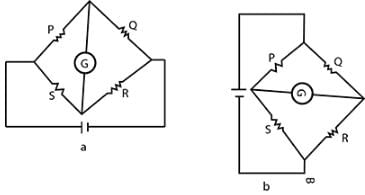Class 12 Exam > Class 12 Questions > When the position of cell and galvanometer in...
Start Learning for Free
When the position of cell and galvanometer in a Wheatstone bridge is inter-changed, its balanced condition
- a)Changes and depends on galvanometer position only
- b)Changes
- c)Changes and it depends on cell position only
- d)Remains unchanged
Correct answer is option 'D'. Can you explain this answer?
Verified Answer
When the position of cell and galvanometer in a Wheatstone bridge is i...
For balanced Wheatstone bridge which is shown in figure a, P/Q=S/R
If we interchange the cell and galvanometer then circuit becomes as shown in figure b.
and balanced condition, P/S=Q/R⇒P/Q=S/R
Thus, balanced point remains unchanged.

If we interchange the cell and galvanometer then circuit becomes as shown in figure b.
and balanced condition, P/S=Q/R⇒P/Q=S/R
Thus, balanced point remains unchanged.

Most Upvoted Answer
When the position of cell and galvanometer in a Wheatstone bridge is i...
For balanced Wheatstone bridge which is shown in figure a, P/Q=S/R
If we interchange the cell and galvanometer then circuit becomes as shown in figure b.
and balanced condition, P/S=Q/R⇒P/Q=S/R
Thus, balanced point remains unchanged.

If we interchange the cell and galvanometer then circuit becomes as shown in figure b.
and balanced condition, P/S=Q/R⇒P/Q=S/R
Thus, balanced point remains unchanged.

Free Test
FREE
| Start Free Test |
Community Answer
When the position of cell and galvanometer in a Wheatstone bridge is i...
balanced condition is the condition in which the current does not flow through the galvanometer.. now cell and galvanometer are replaced.. since the symmetry is undisturbed in case of resistance, their will still be no deflection as u know the galvanometer is still in parallel u can say to all of them..

|
Explore Courses for Class 12 exam
|

|
Question Description
When the position of cell and galvanometer in a Wheatstone bridge is inter-changed, its balanced conditiona)Changes and depends on galvanometer position onlyb)Changesc)Changes and it depends on cell position onlyd)Remains unchangedCorrect answer is option 'D'. Can you explain this answer? for Class 12 2025 is part of Class 12 preparation. The Question and answers have been prepared according to the Class 12 exam syllabus. Information about When the position of cell and galvanometer in a Wheatstone bridge is inter-changed, its balanced conditiona)Changes and depends on galvanometer position onlyb)Changesc)Changes and it depends on cell position onlyd)Remains unchangedCorrect answer is option 'D'. Can you explain this answer? covers all topics & solutions for Class 12 2025 Exam. Find important definitions, questions, meanings, examples, exercises and tests below for When the position of cell and galvanometer in a Wheatstone bridge is inter-changed, its balanced conditiona)Changes and depends on galvanometer position onlyb)Changesc)Changes and it depends on cell position onlyd)Remains unchangedCorrect answer is option 'D'. Can you explain this answer?.
When the position of cell and galvanometer in a Wheatstone bridge is inter-changed, its balanced conditiona)Changes and depends on galvanometer position onlyb)Changesc)Changes and it depends on cell position onlyd)Remains unchangedCorrect answer is option 'D'. Can you explain this answer? for Class 12 2025 is part of Class 12 preparation. The Question and answers have been prepared according to the Class 12 exam syllabus. Information about When the position of cell and galvanometer in a Wheatstone bridge is inter-changed, its balanced conditiona)Changes and depends on galvanometer position onlyb)Changesc)Changes and it depends on cell position onlyd)Remains unchangedCorrect answer is option 'D'. Can you explain this answer? covers all topics & solutions for Class 12 2025 Exam. Find important definitions, questions, meanings, examples, exercises and tests below for When the position of cell and galvanometer in a Wheatstone bridge is inter-changed, its balanced conditiona)Changes and depends on galvanometer position onlyb)Changesc)Changes and it depends on cell position onlyd)Remains unchangedCorrect answer is option 'D'. Can you explain this answer?.
Solutions for When the position of cell and galvanometer in a Wheatstone bridge is inter-changed, its balanced conditiona)Changes and depends on galvanometer position onlyb)Changesc)Changes and it depends on cell position onlyd)Remains unchangedCorrect answer is option 'D'. Can you explain this answer? in English & in Hindi are available as part of our courses for Class 12.
Download more important topics, notes, lectures and mock test series for Class 12 Exam by signing up for free.
Here you can find the meaning of When the position of cell and galvanometer in a Wheatstone bridge is inter-changed, its balanced conditiona)Changes and depends on galvanometer position onlyb)Changesc)Changes and it depends on cell position onlyd)Remains unchangedCorrect answer is option 'D'. Can you explain this answer? defined & explained in the simplest way possible. Besides giving the explanation of
When the position of cell and galvanometer in a Wheatstone bridge is inter-changed, its balanced conditiona)Changes and depends on galvanometer position onlyb)Changesc)Changes and it depends on cell position onlyd)Remains unchangedCorrect answer is option 'D'. Can you explain this answer?, a detailed solution for When the position of cell and galvanometer in a Wheatstone bridge is inter-changed, its balanced conditiona)Changes and depends on galvanometer position onlyb)Changesc)Changes and it depends on cell position onlyd)Remains unchangedCorrect answer is option 'D'. Can you explain this answer? has been provided alongside types of When the position of cell and galvanometer in a Wheatstone bridge is inter-changed, its balanced conditiona)Changes and depends on galvanometer position onlyb)Changesc)Changes and it depends on cell position onlyd)Remains unchangedCorrect answer is option 'D'. Can you explain this answer? theory, EduRev gives you an
ample number of questions to practice When the position of cell and galvanometer in a Wheatstone bridge is inter-changed, its balanced conditiona)Changes and depends on galvanometer position onlyb)Changesc)Changes and it depends on cell position onlyd)Remains unchangedCorrect answer is option 'D'. Can you explain this answer? tests, examples and also practice Class 12 tests.

|
Explore Courses for Class 12 exam
|

|
Signup for Free!
Signup to see your scores go up within 7 days! Learn & Practice with 1000+ FREE Notes, Videos & Tests.
























